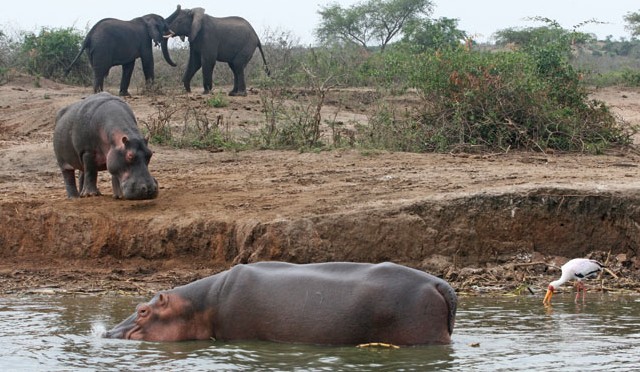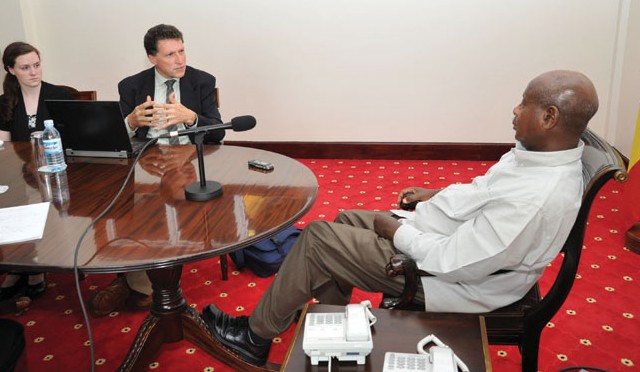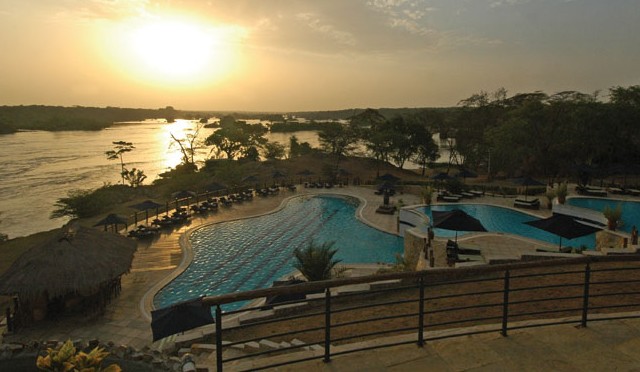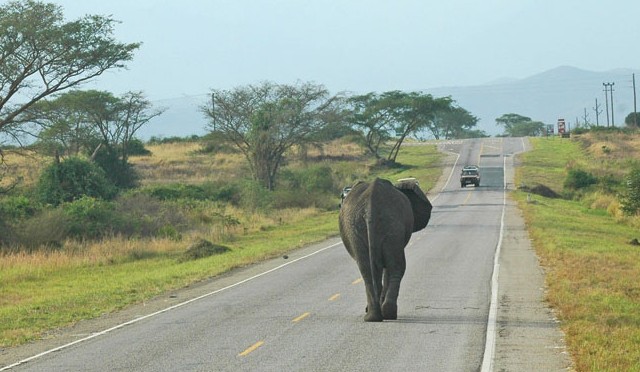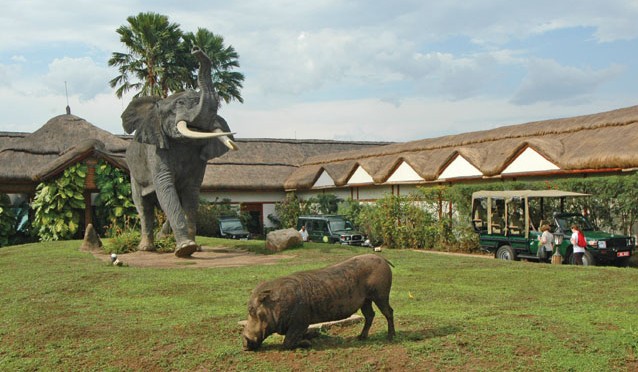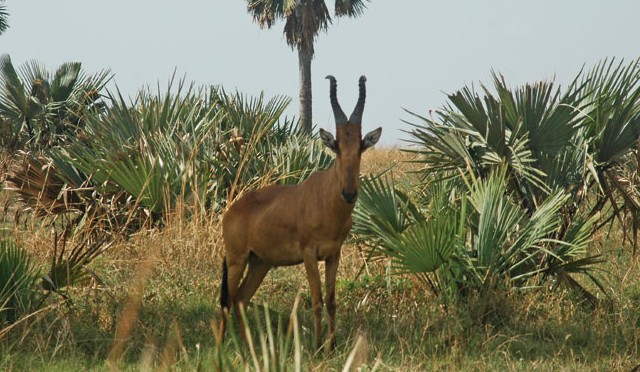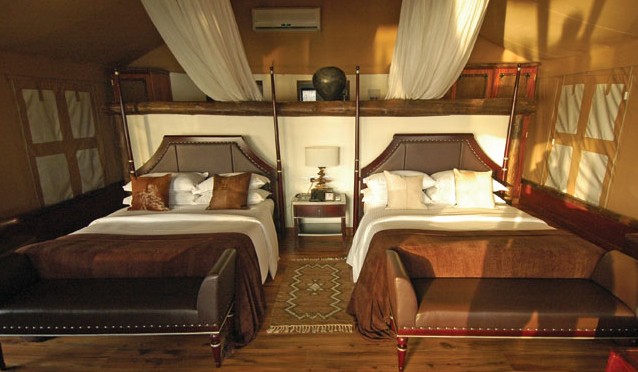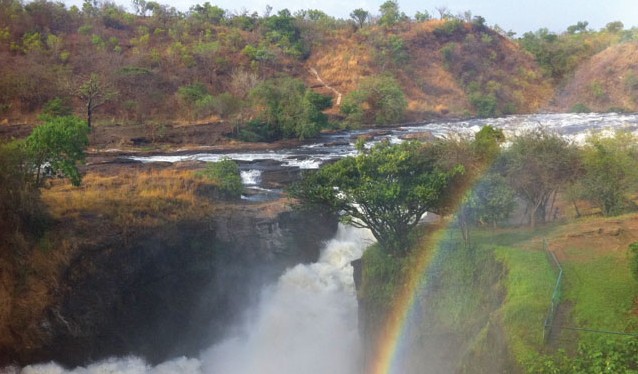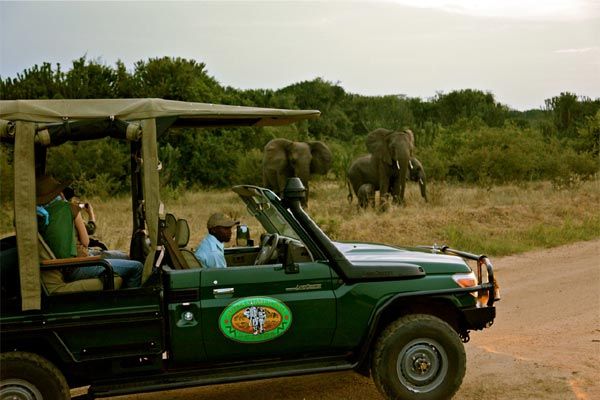By Arnie Weissmann | Travel Weekly – When it comes to the African safari business, Kenya, Tanzania, South Africa and Botswana get the lion’s share. And the market share. And the mind share. But there are challengers. Namibia has generated a lot of buzz lately with high-end game viewing in desert settings. Zambia offers a downright wild look at wildlife, and Zimbabwe had been making steady gains before it obtained pariah status under its president, Robert Mugabe. Even low-key Malawi has its share of fans.
But mention Uganda, and game-viewing is not what comes to mind. Most people immediately think of the ruthless dictator Idi Amin (deposed 33 years ago), war criminal Joseph Kony (evicted five years ago) and virulent anti-gay legislation, which was proposed in 2009 but has yet to make it to the floor of the National Assembly for a vote (see related report, “From president Museveni, reassurances, rationales on hot-button issues”).
Whatever its merits as a game destination, for Uganda to even be considered by a traveler, a number of unsettling associations have to be set aside.
Last year, I met Roni Madhvani, scion of a prominent Ugandan family with diversified business interests. Madhvani, under his family’s Marasa Africa division, has begun to acquire game lodges in East Africa. In Kenya, he took over the well-known Aberdare Country Club and the Ark from Fairmont. He had previously bought Mara Leisure Camp in Masai Mara National Park. He has also collected four lodges in Uganda with the idea of facilitating cross-border experiences (in addition to the three lodges mentioned in this article, in May he closed on the Silverback Lodge in the Bwindi Impenetrable Forest National Park).
I was aware that primates — mountain gorillas and chimpanzees — could be seen in Uganda but was under the impression that its more traditional wildlife parks had not fully recovered from the years of neglect that followed the Amin regime. Madhvani, however, told me that great progress had been made and urged me to consider a visit to the parks. When he followed up with an invitation earlier this year, I accepted.
I’d previously been on wildlife-viewing safaris in seven African countries, as well as gorilla-trekking in Rwanda, and I’ve found that each destination has an aspect that emerges to become the defining differentiator. As I prepared to visit Uganda, I wondered what that prime differentiator would be.
Kampala considered
Unless one is whisked by private plane to a lodge directly from an international airport, the first impressions of an African safari destination are likely to be urban in nature. I found that the 45-minute drive from the airport in Entebbe to Uganda’s capital, Kampala, provided a bit of insight into the country.
I saw a few marabou storks and vervet monkeys en route, but I soon became more interested in the commercial signage: We passed the Jesus Cares Supermarket, the Formula 1 Guest House and the Jackson 5 Restaurant. (Truth in advertising may have gone further than necessary at the Tick Hotel, which I passed the following day.) English and Swahili are both official languages in Uganda. It was a British protectorate, rather than a colony, and a guide later told me that although the practical differences may have been slight, they nonetheless resulted in less general resentment of the period of British rule.
I found Kampala to be clean and friendly, and the areas I saw seemed far less edgy than, say, Nairobi. I felt comfortable walking around alone. Though I had seen some signs of poverty on the drive between Entebbe and Kampala, Uganda is relatively prosperous: Oil has been discovered, and it’s one of the few sub-Saharan countries that is a net exporter of food.
The hotel I stayed in, the 150-room Kampala Serena, was on an expansive, landscaped campus and maintained four-star-plus international standards. To my surprise, it also had a spa with one of the finest fitness centers I’ve seen anywhere.
The morning after arrival, we headed overland to Chobe Safari Lodge (not related to Botswana’s famous Chobe Game Lodge) in Murchison Falls National Park, about 170 miles northwest of the capital city via a well-paved road. En route, we saw herons, storks, eagles and ibis. We also made a stop that enabled us to check off the first of the “big five” animals (lion, leopard, rhino, buffalo and elephant) that we were to see.
Rhino walk
The 27-square-mile Ziwa Rhino Sanctuary has been set aside to breed and eventually reintroduce rhinos into the wild. (The last Ugandan rhino in its natural habitat was killed almost 30 years ago). The 40 or so rhinos now at Ziwa were seeded with animals donated by a reserve in Kenya and by Disney’s Animal Kingdom in Orlando (one baby, with a Kenyan father and American mother, is named Obama). They are guarded by armed rangers who follow them around, on foot, 24 hours a day.
Visitors also approach Ziwa rhinos on foot. Before we set out to see them, we were given instructions: Walk quietly, in single file; do not get closer than 50 meters; if a rhino charges — and it has happened on occasion — climb the nearest tree.
The terrain we crossed was both open and forested, and after hiking about 15 minutes, we came upon a family of three white rhinos resting in broken shade at the edge of a thicket. I have seen rhinos several times, but I saw something I had never seen before: a calf nursing.
Rhinos have poor eyesight. We were about 50 meters away, and though one of them occasionally appeared to hear us and look our way, they didn’t seem overly concerned. Nonetheless, we all took note of the nearest tree, which didn’t seem nearly sturdy enough to hold our group of eight.
We saw one other rhino on the way back: a large dominant male, also resting in the shade. Remarkably, we had walked right past it on our way in, without noticing it on the other side of a thicket just yards away. Fortunately for us, it was asleep: Our guide said it was the most aggressive animal in the park.
Uganda’s differentiator
As soon as we left Ziwa and turned onto the road for the 1,500-square-mile Murchison Falls National Park in northwestern Uganda, we began to see more animals. A few antelope — oribi, kob and spotted bushbuck — were in the open areas of the rhino sanctuary, and we had also spied an iridescent blue starling and a large, glossy black obsidian hornbill.
But as we approached Chobe Safari Lodge, antelope began to more-or-less line the road. The reddish kob are particularly striking, with distinctive curved, banded horns (native to Uganda, they’re on the country’s seal).
After walking into and through the lobby of Chobe Safari Lodge, we saw Uganda’s prime differentiator in breathtaking form: The sun was beginning to set over a wide bend of the White Nile, a pod of hippos dotting the water near shore.
Although I knew the White Nile originated in Uganda (it joins the Blue Nile, whose source is in Ethiopia, in Khartoum), I had no idea it was already so wide and majestic at this relatively early point in its journey to the Mediterranean.
Chobe Safari Lodge could not be better situated. Although it’s almost 60 years old, it underwent an extensive renovation and reopened in 2010 as a “super deluxe” property worthy of the designation. At $335 a night, all-inclusive for two people, for a luxury, air-conditioned tented room with Nile views, it is a bargain. There are both less expensive standard rooms in the main building and larger presidential and bridal suites. I was particularly impressed with the location and views of tented rooms No. 8 and No. 7; the latter, however, has only twin beds.
The lodge also has meetings facilities for 60 to 120 people.
Although we didn’t go on a formal game drive at Chobe, we saw animals. From the porch of my tent, I saw baboons, and after dark, hippos emerged and munched the grass between my tent and the river. (After dark, transportation between the lodge and tented suites is by golf cart rather than on foot: Hippos are responsible for more human deaths than any other animal in Africa.) In the morning, we saw a small herd of elephants enjoying a walk through the shallows.
I was eventually to discover that although we would spend hours over the next week on game drives, it is memories of life along the White Nile and farther south, the Kazinga Channel, that most clearly defines and differentiates the Uganda wildlife experience. And the several water-related activities we participated in were not homogenous: Each of the three riverside lodges we stayed at offered surprisingly different scenery and ways to experience the fresh water.
The White Nile explored
Madhvani’s Marasa Africa group owns another lodge in Murchison Falls National Park, Paraa Safari Lodge. We began to see more and varied mammals as we moved deeper into the park on our way to Paraa: not only Cape buffalo, warthogs and waterbuck, but subspecies I had never seen before, such as the highly endangered Rothschild giraffe (it’s one of two parks in the world where they live), lelwel hartebeest and the ground-dwelling pata monkey. The bird life went up a few notches as well, with kites, bustards and guinea fowl present.
By international standards, I’d rate Paraa two to three stars; two for the standard rooms which are comfortable, but small (and, at least in my wing, windowless), and three for the common areas. Service was excellent.
Paraa sits near the juncture of the Victoria Nile (which originates near Lake Victoria) and the Albert Nile (fed by Lake Albert, along the border with the Republic of Congo). We saw lions and a leopard on the first evening’s game drive, and the next morning we went closer to the river, spotting dozens more birds (the nation claims 1,064 species of migratory and resident birds), including the beautiful carmine bee-eater and white-throated bee-eater, as well as large water fowl.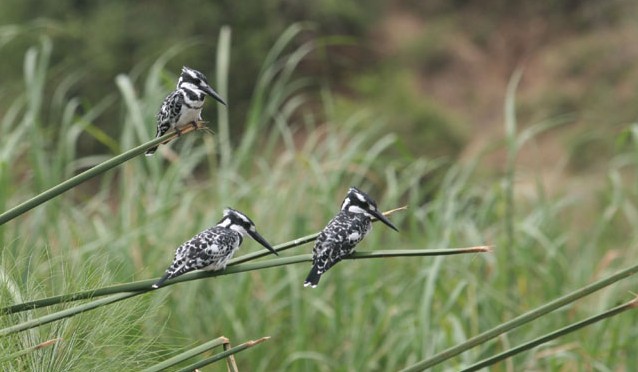
But the highlight of our time at Paraa was a boat trip to Murchison Falls, where the Nile waters are forced through an opening only about 20 feet wide before plunging 143 feet. (The movie “The African Queen” was filmed in the park.) En route to the falls, we passed dozens of pods of hippos, viewed even more stunning and spectacular bird life and saw colobus monkeys in trees on the river’s edge. The crocodiles were particularly active: Most I’d seen before were so still they may as well have been mounted, but the crocs on this portion of the river were restless, entering and leaving the water, sometimes doing a glide-by to check us out.
Along one muddy bank, a congregation of four adult crocodiles were watching over two newborns that couldn’t have been more than 12 inches long, tail-to-snout.
Shortly after the cascades came into view, we got off the boat for a 20-minute, moderate (though sometimes steep) hike to the top of the falls. Our reward was not only views of the rainbow-misted falls but a perfect perch to watch the meandering Nile for as far as the eye could see, the sun glinting off its calming surface.
Headed south
From Murchison Falls, we flew to the southwest corner of the country, to Queen Elizabeth National Park and the Mweya Safari Lodge. The park blankets the Great Rift Valley where Lake Edward and Lake George are connected by the Kazinga Channel. The 760-square-mile park is also adjacent to the Kyambura Gorge, where chimpanzees live.
Queen Elizabeth also offers abundant game, with multigenerational herds of elephants. We saw lions twice and even saw a leopard walking through a field in broad daylight. I was happy to add another new animal to my “seen” list: the giant forest hog.
But once again, a boat ride stole the show. We spent an afternoon moving up the Kazinga Channel from Lake Edward to Lake George, and life along its banks was very different from the Nile trip to the falls, but every bit as interesting.
A broad, flat bank directly opposite the lodge attracted elephants, hippos and buffalo, which appeared to co-exist peacefully. Bird life ranged from tiny kingfishers to imposing fish eagles. In places, the bank was lined with papyrus plants.
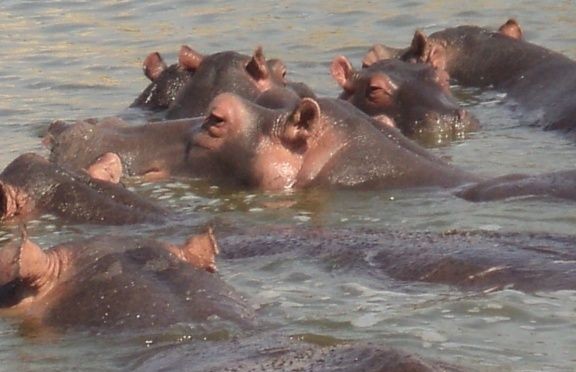 At the far end of the channel, just before it opens onto Lake George, a fleet of fishermen in dugout canoes loaded with nets launched into the channel, paddling heart-shaped oars toward the open water. A lone Cape buffalo wandered along the main road through the village; the residents didn’t seem overly concerned, but gave it wide berth.
At the far end of the channel, just before it opens onto Lake George, a fleet of fishermen in dugout canoes loaded with nets launched into the channel, paddling heart-shaped oars toward the open water. A lone Cape buffalo wandered along the main road through the village; the residents didn’t seem overly concerned, but gave it wide berth.
The areas we saw on game drives at Queen Elizabeth tended to be flatter and less forested than farther north. We were brought to a small, perfectly circular crater lake that has become a salt pan; a cluster of pink flamingoes formed a tight knot in a shallow area near its center. The park is just south of the equator, and during one drive our guide took us to markers that straddled it.
Mweya Safari Lodge also features luxury tented suites, comparable to what’s available at the Chobe Safari Lodge. The common areas, while generally very nice (four star-plus), are not quite up to the more recently renovated Chobe. There are some standard rooms that are more serviceable than special, but overall, the ambience is very pleasant.
Like Chobe, if one wants to go from the main lodge to the tented suites after dark, it’s advised to do so with a golf cart. On my last night, I found out why. Upon arriving at my tent, I saw a hippo on the lawn. The driver and I returned to the main lodge. About 10 minutes later, another driver said the hippo had moved on, so we went back, only to find that it had moved directly in front of the steps to my porch. Third time was a charm, but I confess to wondering as I approached the porch, most of which was in shadow, whether hippos could climb stairs.
Who should go
None of the lodges I went to were full — the general manager at Paraa said occupancy averaged around 63% in 2011, up a couple of points from 2010 — and in Chobe, the group I was with were the only guests. The GMs indicated that most visitors were Ugandans, followed by Americans, then Brits. With the recent discovery of oil in Uganda, increasingly guests are foreign workers in the petroleum industry.
Currently, Uganda represents very high value for an African game-viewing destination. The friendly nature of hotel staffs, guides and park personnel would certainly put even first-timers at ease. The guides and vehicles were provided by Premier Safaris, another of Madhvani’s companies, and I could not imagine a more knowledgeable guide than Marc Obwalatum, who accompanied our group.
The infrastructure — roads, hotels and airport — exceeded my expectations.
The most direct flights are from Washington via Addis Ababa, Ethiopia, on Ethiopian Airlines and on British Airways via London; all things equal (both are excellent carriers), going via Addis’ airport has the added benefit of providing a small taste of that country, as well.
Certainly one of Uganda’s strengths is that it would appeal to both experienced and inexperienced visitors. It’s a user-friendly introduction to the continent, yet offers a lot for visitors who have been to Africa multiple times. I was drawn to the White Nile and chimp experiences, which were unlike anything I had seen before.
Its cross-border pairing with Kenya, as Madhvani envisions, particularly with the addition of the new Silverback Lodge, would be ideal and could become a formidable challenge to the traditional Kenya-Tanzania combination. Madhvani has his work cut out for him to counter public perceptions about Uganda.
Fortunately, he has a lot to work with.
Source: Ugandan diaspora news

